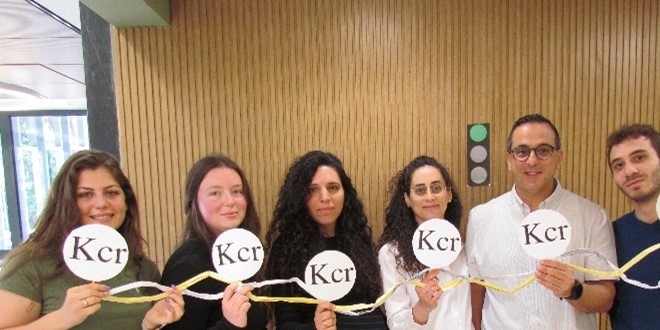Cells in the human body – the blood, bone, muscles, skin, lung hair, nails and others – divide all the time to make new one. When the genetic material of the DNA – a double-stranded molecule located at the nucleus of each cell of our body – divides in a process called mitosis, the molecules can experience hundreds of thousands of mutations every day. But it has not been well understood what regulates repair of the DNA.
Now, scientists in the Faculty of Biology at the Technion-Israel Institute of Technology in Haifa have discovered a new mechanism unknown until now that regulates DNA damage repair. The study, published in Molecular Cell under the title “CDYL1-dependent decrease in lysine crotonylation at DNA double-strand break sites functionally uncouples transcriptional silencing and repair,” was conducted by Prof. Nabieh Ayoub and members of his research group, Enas Abu-Zhaiya, Laila Bishara, Feras Machour, Alma Barisaac and Bella Ben-Oz.
One of the most dangerous DNA lesions is a double-stranded break (DSB) that affects both strands of DNA. Fortunately, our cells contain hundreds of proteins that are involved in repairing these mutations and keeping our DNA intact. Defective DSB repair can lead to accumulation of mutations compromising the stability of our genome, which contributes to premature aging, developmental disorders, neurodegenerative diseases, and cancer. For example, loss of BRCA1 or BRCA2 gene (two critical genes for proper repair of DSBs) might lead to the development of breast and ovarian cancer.
Transcription refers to the process of copying the information in DNA to a new molecule of messenger RNA that can encode proteins. DSB induction that happens close to active genes inhibits transcriptional activity to avoid transcribing broken genes (known as DSB-induced transcriptional silencing). Failure to neutralize broken genes can cause cancer.
While it is widely accepted today that DSB-induced transcriptional silencing is necessary for effective DSB repair, the mechanisms that ensure DSB-induced transcriptional silencing have remained largely unknown.
Ayoub’s lab has focused on understanding how cells repair DSBs, identifying new repair proteins and characterizing their role in DNA damage repair and cancer development. Their ultimate goal is to translate these discoveries into diagnostic and therapeutic approaches to selectively eradicate cancer cells.
Recently, scientists from Prof. Ayoub’s lab discovered a dual role of CDYL1 protein in DSB repair and in DSB-induced transcriptional silencing. The researchers showed that CDYL1 protein is quickly recruited to DSB sites and contributes to their repair. In addition, they discovered that CDYL1 protein participates in DSB-induced transcriptional silencing.
The researchers found that contrary to the current belief among scientists, DSB-induced transcriptional silencing is not required for intact DSB repair. Broadly speaking, these findings expand our understanding of the mechanism that regulates gene expression after DNA damage, and shed new insights into the dialogue between DNA repair and transcription regulation.
The shortcode is missing a valid Donation Form ID attribute.



